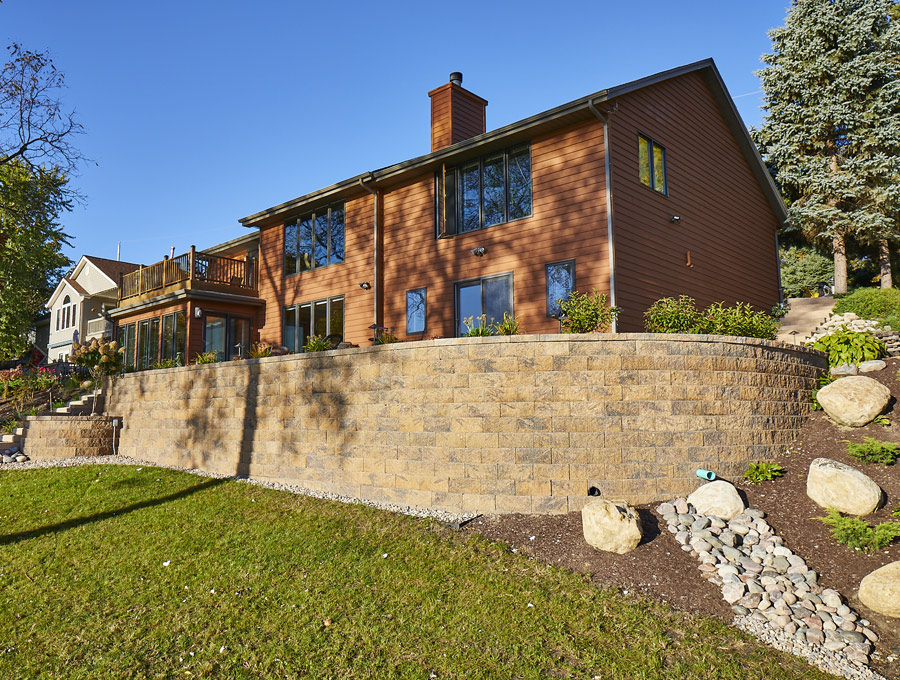Everything You Need to Know About Retaining Walls

If your home is built on a slope or hill, you probably have a retaining wall on your property. Here’s what you should know about retaining walls and how they can improve your outdoor living space.
What Are Retaining Walls?
A retaining wall is designed to hold back soil and prevent it from eroding or collapsing. They’re typically used to level out a sloped yard or create more usable space on a property. They’re also installed to emphasize and define space or create an attractive focal point in your landscape. If they’re constructed well, they can last up to 50 years.
How to know if you need one
If your land is sloped or near the edge of a slope, you probably should consider building a retaining wall. You also might need a retaining wall after you build a new feature on your property, such as a swimming pool or garage, or if any ground has shifted and slipped away due to extreme weather. You’ll definitely need a well-built retaining wall if you notice areas of poor drainage or water pooling in your yard.
If you already have a retaining wall, check for the following signs to know if you should replace it:
- Bowing or leaning forward
- Sections blown out by dirt or tree roots
- Discoloration of the stone
- Water seepage through the wall
- Gapping between blocks or bricks
- Any signs of animal infestation
Why install a retaining wall
Manage drainage. Retaining walls redirect water away from your home and low-lying areas of your yard toward a drainage system. This helps prevent water pooling on your lawn, which can lead to mold and damage plant root systems, to maintain the integrity of your lawn and surrounding landscape.
Prevent damage. They also help prevent soil erosion, which can cause damage to your property and affect the environment, and water damage to your home or other structures on your property.
Add space and appeal. From natural stone and wood to concrete block, retaining walls can be designed to fit the style and functionality you’re looking for. They can create designated focal points, such as a water feature or ornamental garden bed, and they can be built in nearly any shape or height to give a thoughtful, refined look to your entire property.
Building a retaining wall
Although it might seem simple, building a retaining wall is a deceptively complex task. There are many factors to consider, and homeowners often don’t have the expertise or access to the professional-grade materials that make a retaining wall last for years to come.
Engineer it. Many retaining walls need the expertise of an engineer, who will assess the soil composition, direct the depth of stone and define materials to create a detailed engineering plan and ensure long-term success.
Choose the right materials. Most retaining walls should be built with manufactured concrete block, which has high compressive strength – much higher than natural stone or wood. Concrete blocks also fit tightly together, preventing animals from disrupting the structure. A retaining wall should also include a geogrid layer to reinforce the soil behind the wall and increase its stability, as well as drainage tiles to drain away groundwater.
Pro Tip: Most retail stores carry blocks that don’t have the same strength and durability of materials that landscape professionals can access. Work with an experienced contractor to ensure you get highly durable, long-lasting components that will give you decades of functionality from your retaining wall.
Consider maintenance. When choosing materials, balance style and function with maintenance. For example, natural stone often requires routine mulching, weeding, replanting and moss control. Wood walls need to be regularly sanded and stained to maintain their aesthetic appeal and prevent rot. Concrete block requires little to no maintenance, which is another reason why it’s a popular choice.
Create a foundation. All walls must be supported underground by aggregate – never dirt or topsoil. Soil absorbs water and swells when saturated, which puts pressure on the back of the wall and can cause it to fail. Aggregate, including gravel and sand, won’t absorb moisture and will redirect water while maintaining the integrity of the wall.
Build with technology. A reputable landscaper will use a variety of tools to build retaining walls, including GPS equipment, to manage difficult layouts and unusual terrain. Work with a contractor that has access to this critical technology to ensure high-quality construction.
Partner with a pro
The Reesman Company has deep expertise in building long-lasting, beautiful retaining walls. Let our knowledgeable team design and build a wall that adds function, style and curb appeal to your home while increasing your outdoor living space. Call 262-539-2124 to speak with one of our landscape professionals or contact us for more information.



